Killara (original) (raw)
For the river in Victoria known as Killara, see Darlot Creek.
Suburb of Sydney, New South Wales, Australia
| KillaraSydney, New South Wales | |
|---|---|
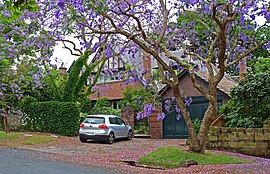 Residential home, Springdale Road, Killara Residential home, Springdale Road, Killara |
|
 |
|
| Population | 10,620 (2021 census)[1] |
| • Density | 2,181/km2 (5,648/sq mi) |
| Established | 1821 |
| Postcode(s) | 2071 |
| Elevation | 120 m (394 ft) |
| Area | 4.87 km2 (1.9 sq mi) |
| Time zone | AEST (UTC+10) |
| • Summer (DST) | AEDT (UTC+11) |
| Location | 14 km (9 mi) north-west of Sydney CBD |
| LGA(s) | Ku-ring-gai Council |
| State electorate(s) | Davidson |
| Federal division(s) | Bradfield |
| Suburbs around Killara: Gordon Gordon East Killara West Pymble Killara East Lindfield Macquarie Park Lindfield Lindfield |
Killara () is a suburb on the Upper North Shore of Sydney in the state of New South Wales, Australia. Killara is located 14 kilometres (8.7 mi) north-west of the Sydney central business district in the local government area of Ku-ring-gai Council. East Killara is a separate suburb and West Killara is a locality within Killara.
 |
This section needs to be updated. The reason given is: Has Marian Street Theatre been reopened?. Please help update this article to reflect recent events or newly available information. (January 2024) |
|---|
The first Europeans to inhabit the area were convicts and their overseers, who set up a timber-getting camp around 1805, on the banks of the Lane Cove River. On 5 April 1821, five crown grants of land comprising Killara were given to settlers by Lachlan Macquarie, including 40 acres to Joseph Fidden. Killara Marian Street theatre has not been reopened.
Killara is an Aboriginal word meaning permanent or always there.[2] The name of the suburb was chosen when the railway line opened in 1899. James George Edwards was a representative of the people who requested a station be built here. The suburb was established as a "Gentlemen's suburb", designed so that there would be no commercial ventures in the area. For this reason, the suburb has very few shops in the original development.[2]
Killara Post Office opened on 7 November 1904.[3]
Killara later became the home of the architect Harry Seidler, whose home—designed by him and his wife Penelope in the 1960s—can still be seen in Kalang Avenue. It is sometimes known as Killara House and sometimes as Harry and Penelope Seidler House. The couple moved into the house on Harry Seidler's birthday in 1967. The garden contains a sculpture by the Los Angeles sculptor Eric Orr. The house is heritage-listed.[4]
Marian Street Theatre played a significant role in the cultural life of the North Shore. The theatre is temporarily closed for renovation works.[_timeframe?_][5]
Killara has a number of heritage-listed sites, including:
- 13 Kalang Avenue: Harry and Penelope Seidler House[6]
- 1 Werona Avenue: Woodlands, Killara[7]
Killara is home to a train station that connects to the T1 and T9 lines for routes to Berowra via Gordon, City via Gordon on the T1 or routes through North Shore via City on the T9.[8]
The Pacific Highway is the main road thoroughfare through Killara.
CDC NSW operates two bus routes through Killara:
- 556: Lindfield to East Killara[9]
- 565: Chatswood to Macquarie University via Roseville, Lindfield and Macquarie Park[10]
The Swain Gardens were donated to Ku-ring-gai Council by Mr Swain, a Sydney bookseller, in the 1920s, and are today maintained by the council and volunteers. The gardens have been listed by the National Trust of Australia.[_citation needed_]
Killara is served by two public primary schools, Killara Public School and Beaumont Road Public School.[11] The suburb is also home to Killara High School, one of the highest performing non-selective government secondary school in New South Wales.[12][13] A short-lived private school in Killara, Abbotsholme College, counted two future prime ministers[_which?_] among its pupils.[14][15]

Greengate Hotel, Pacific Highway
Killara Uniting Church designed by Carlyle Greenwell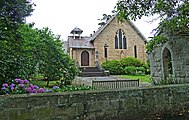
St Martin's Anglican Church
Killara is also home to some child care centres, including Handprints Pre School and Child Care.[16]
Churches in the suburb include St Martin's Anglican Church and Killara Uniting Church (formerly Killara Congregational Church) on Karranga Avenue.[_citation needed_]
Killara has recreational sport centres including Killara lawn tennis club[17] and Killara golf club,[18] which is ranked in the top 100 golf courses in Australia and picturesque views to the Blue Mountains has attracted golfers.
Commercial developments are located along the Pacific Highway, including the Greengate Hotel,[19] Beacon Lighting, Poolwerx, and Killara hotel. Residents usually travel to nearby suburbs of Gordon, Macquarie Park and Chatswood for regular shopping.
The majority of residential properties are built in the Federation and Californian Bungalow styles, although the suburb includes many other styles.
The Harry and Penelope Seidler House at 13 Kalang Avenue was designed by Harry and Penelope Seidler. The 1960s-era modern-design home, constructed with reinforced masonry walls, concrete floors and roof, rubble-stone retaining walls and fireplace, won the Wilkinson Award in 1967.

Federation house, Arnold Street
Federation bungalow, Northcote Avenue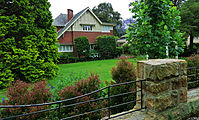
Arts and crafts house, Arnold Street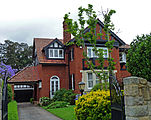
Tudor revival house, Arnold Street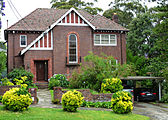
Tudor revival house, Stanhope Road
Neoclassical (post-war) house, Stanhope Road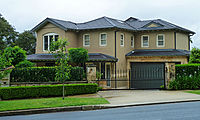
Federation revival house, Springdale Road
Contemporary home, Kylie Avenue
Modern house (c. 2005), Arnold Street
Old English house common within the area
The home of architect Harry Seidler in Kalang Avenue
For federal elections, Killara lies in the electorate of Bradfield, currently represented by Paul Fletcher. For state elections, Killara falls under the state electoral district of Davidson. The member for Davidson is Matt Cross. In terms of local government, Killara is part of the Ku-ring-gai municipal council.
Rosetta Avenue
In the 2021 Australian census, the total population of Killara was 10,620 people; 48.1 percent were male and 51.9 percent were female. 50.6% of people were born in Australia. The most common other countries of birth were China 13.8%, England 4.3%, Hong Kong 4.0%, South Korea 2.7% and India 2.2%. 56.1% of people only spoke English at home. Other languages spoken at home included Mandarin 17.3%, Cantonese 7.8%, Korean 3.4%, Hindi 1.1%, and Japanese 1.0%. The most common responses for religion were No Religion 43.4%, Catholic 15.4% and Anglican 12.5%, Of persons aged 15 years and over, 57.4% were married, 29.0% never married, 5.5% widowed, 6.2% divorced, and 1.8% separated.[1]
The median weekly personal income was 1,117,comparedwith1,117, compared with 1,117,comparedwith805 nationally. The median weekly household income was 2,802,comparedwith2,802, compared with 2,802,comparedwith1,746 nationally. The median weekly family income was 3,294,comparedwith3,294, compared with 3,294,comparedwith2,120 nationally.[1]
At the 2021 census, 54.7% of occupied private dwellings were separate houses and 42.6% were flat or apartments. The average household size was 2.8 people.[1]
- John Alexander OAM MP- Tennis champion and former Federal Member for Bennelong
- Robert Alan Crook – electrical engineer, owner of Alan Crook Electrical manufacturers
- Kim Gamble – children's book illustrator and artist
- Carlyle Greenwell – Architect, philanthropist and designer of Killara Uniting Church and many, now heritage listed, houses[20][21][22][23]
- Peter Jackson – boxer, British Commonwealth and Heavyweight champion
- David Koch, an Australian financial analyst, television presenter and host of Sunrise on the Seven Network
- Elle Macpherson – grew up in Killara and also attended the local high school, Killara High School
- Harry Messel – head of the School of Physics at Sydney University, Australian Atomic Energy Commission (1975-1981), Chancellor of Bond University (1992-1997)
- Charles Scrivener – surveyor
- Penelope Seidler – architect
- Ethel Turner – author of Seven Little Australians, lived on a large property now known as Kiamala Crescent
- Jim Waley – a former presenter and newsreader for National Nine News
- Zeny Edwards and Joan Rowland (2008). "Killara". Dictionary of Sydney. Retrieved 27 September 2015. [CC-By-SA]
- Ailsa McPherson (2012). "Marian Street Theatre, Community Theatre and Northside Theatre". Dictionary of Sydney. Dictionary of Sydney Trust. Retrieved 10 October 2015.
33°46′07″S 151°09′48″E / 33.76864°S 151.16347°E / -33.76864; 151.16347
